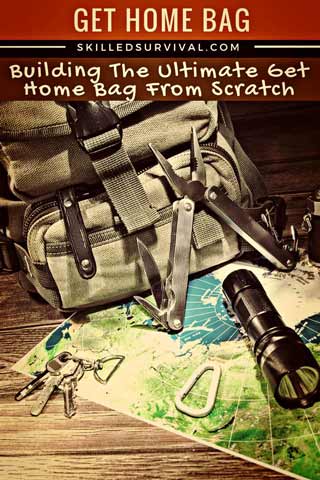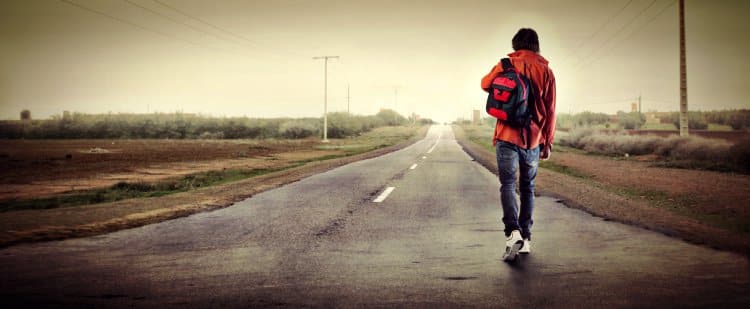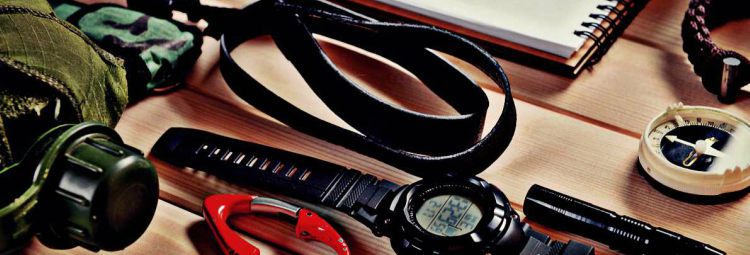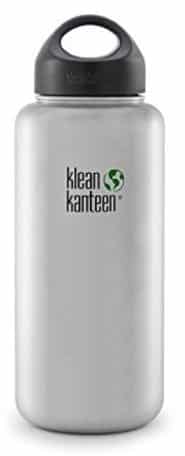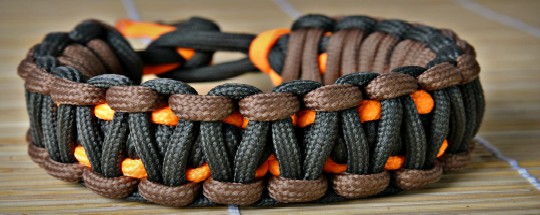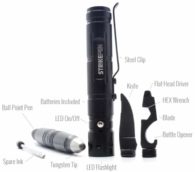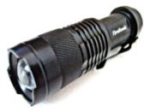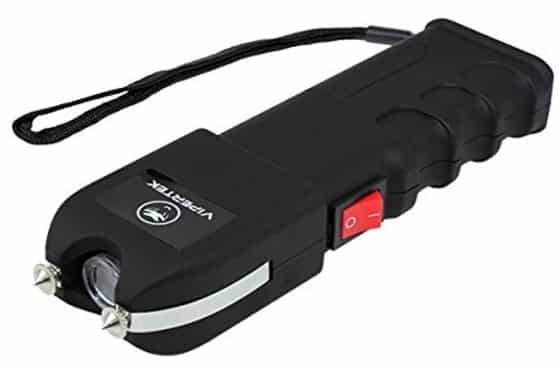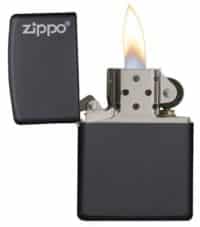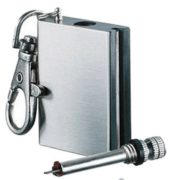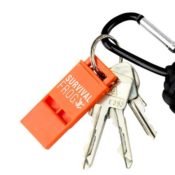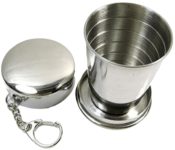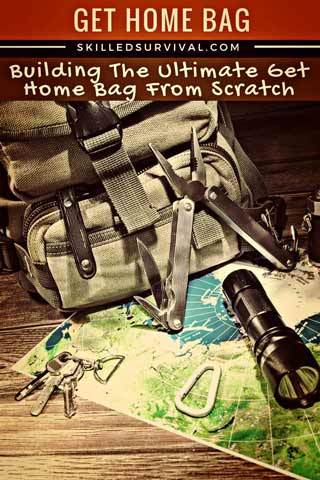
If you work outside the house, you should build a get home bag and take it with you.
No excuses.
Because emergencies happen when you least expect them, and being stranded with no supplies is a very unwise way to live.
You need survival tools and supplies to help you get back to your home base safely and fast.
So let’s cover in detail the following Get Home Bag topics:
- What Is A Get Home Bag
- Who Should Build A Get Home Bag
- The Primary Reason For Having A Get Home Bag
- The Best Get Home Bag To Start Your Build
- The 26 Essential Get Home Bag Contents
As A Way To Introduce You To Skilled Survival, We’re Giving Away Our #78 Item Complete Prepper Checklist. Click Here To Get Your FREE Copy Of It.
What Is A Get Home Bag?
Get home bags are more universal than building other types of survival bags.
Why? Because even if you intend to ride out a massive disaster (and not bug out), you still need tools and supplies to make it home.
What good is stockpiling survival food, storing water and resources if you never make it home to those supplies?
The bottom line is that if you get stuck across town, you need basic survival tools and supplies to help you get home quickly.
As survivalists, there are several different bags we build for specific emergencies. So it’s worth defining exactly what a get home bag is and is not.
- A get home bag is a portable survival bag full of key supplies to support a dangerous trip back home during a widespread survival situation.
- A bug out bag provides supplies to travel for several days to move away from a dangerous location to a secure, safer one.
- A survival pack is a bag built for outdoor adventures. It includes survival supplies if you get lost or injured in the wilderness. It’s a pack to take on a hiking, fishing, climbing, or hunting adventure.
- A medical first aid kit (or trauma kit) is a bag of medical supplies for quickly responding to traumatic events.
- An inch bag is an “I’m Never Coming Home” bag. It’s a bag filled with long-term survival gear. The equipment is necessary for living a nomadic survival lifestyle because you’re “never coming home.”
For A Limited Time – We’re Giving Away Our Most Popular Checklists For FREE!
#104 Item Bug Out Bag Checklist or #78 Item Prepping Checklist
Who Should Build A Get Home Bag
This one’s easy…Everyone!
Especially those in an urban setting who spend a significant amount of time away from their home. Some people even call it an “urban get home bag.”
An urban get home bag is a must for:
- Adults who work outside the home.
- Students who spend many hours at school or on campus.
- Active retirees who are constantly on the go.
Honestly, the list of people who don’t need a get home bag is a shorter one. If you leave your home regularly, you should build yourself a get home bag.
So the only people who shouldn’t build a get home bag are those who are homebound. If this is not you, you should get a get home bag.
Reasons For Needing A Get Home Bag
OK, so if nearly everyone should have a get home bag, there’d better be a damn good reason.
Yes, and there is one; a get home bag is a basic survival tool.
It’s on the same basic level of preparedness as having 2 weeks worth of survival food and filtered drinking water. And that’s why everyone should have a get home bag as well.
A get home bag helps you get home to your supplies and loved ones following a widespread disaster. Especially one that disrupts your ability to use modern transportation.
A widespread disaster where you’re forced to ditch your vehicle to hike home.
But how many scenarios are there where you can’t just drive home? Quite a few, actually…
The most likely is a massive transportation lockdown.
Traffic jams happen in major city’s all the time without significant turmoil. So at the first hint of widespread panic, what do you think will happen? Long-term gridlock.
Or how about an emergency where roads are not passable? Downed bridges or destroyed roadways can become permanently unpassable. Then what?
The most likely “get home” situation is one where you (or a loved one) work at an office across town. A job where you spend nearly 25% of all your hours at.
That’s why you should build a get home bag to help you make it home safely following a widespread disaster.
Especially during a disaster where panic rules the day.
For A Limited Time – We’re Giving Away Our Most Popular Checklists For FREE!
#104 Item Bug Out Bag Checklist or #78 Item Prepping Checklist
The Best Get Home Bag To Start Your Build
We’ll advise you on what to put in your get home bag shortly. But before we do, it’s critical to choose the right get home bag for you.
You need a durable, rugged, portable, well-designed one at the right price.
No old gym bags or free cheap tie bags, please! Do this right if you want a get home bag you can depend on.
The most important aspect of a successful get home bag is its size.
Too big, and it’ll be cumbersome to carry and take with you every day. A full-fledged 72-hour bug out bag is too big for a get home bag.
Too small, and you won’t be able to take all your critical survival items with you. Purses, fanny packs, and small pouches are typically too small for a get home bag.
You also want a bag that can handle real abuse. It should be made of tough materials and seams. You also want durable zippers that won’t break or jam in wet or dirty conditions.
It also helps if your home bag is well-designed with lots of compartments for different supplies and quick access to the most important tools.
Finally, you want a bag with colors that make sense to you. A camouflage get home bag may not fit in with your “professional” office setting – get a black laptop bag instead.
One bag I think makes for a perfect bug-out bag, go bag, or get home bag is The Combat Bag from EVATAC.
Check out my full review of this excellent bag (in the following video review, I call it a bug-out bag but it’s a perfect size for an extensive get home bag as well):
Interested in this bag? Click here to see the insanely affordable price of this quality bag.
The 26 Essential Get Home Bag Contents
1. Stainless Steel Water Bottle
You need a vessel that carries water, but choosing the right type of container is important.
You don’t want plastic, and you don’t want double-walled. Why? Both plastic and double-walled water bottles are terrible options for boiling water.
And boiling water is one of the best ways to purify contaminated water in a pinch.
Plastic bottles will melt when direct heat is applied for boiling. And double-walled insulation makes it difficult to transfer enough heat to the water to get it to a boil.
Double-walled insulation is perfect for keeping liquids inside hot or cold longer. They are good at reducing heat transfer which is the opposite of what you want if you’re trying to boil water.
In a get home emergency, cold water or hot coffee is not the goal; the goal is survival.
Plus, there’s a chance a double-wall insulated bottle can explode under intense heat. Trapped air between the walls will increase in pressure when heated. When pressure rises to the point where the walls of the water bottle fail, that’s called an explosion!
So instead, get a stainless steel single-wall water bottle for your get home bag. Always keep it full of fresh water so you have H2O at the outset of an emergency event.
You’ll also want several methods to purify and filter any water you grab while on the move.
2 & 3. Water Filter and Purification Tablets
It’s impossible to know the number of miles you may have to travel to make it back home.
Yes, you know your typical distance from work to home, but what if you cannot safely take the most direct path back?
That’s why you need several days’ worth of water. But water is heavy, so you’ll need more than you can carry. However, drinking from rivers, lakes, ponds, or streams is risky without the right tools.
Natural water sources can be contaminated with viruses or chemicals – or worse.
So I recommend you pack a survival water filter and water purification tablets.
You should pack a Sawyer Mini Water Filter.
Sawyer Mini Water Filter
I highly recommend you get a couple sawyer mini water filters. Not only is it small to pack and lightweight, but it can also filter 100,000 gallons of water!
This little water filter is ideal for both travel and a worst-case get home survival scenario.
What makes the Sawyer Mini so powerful is its inline design capabilities. Use it as a straw or an inline filter to remove 99.999% of harmful bacteria.
Here’s my full video review of the incredible Sawyer Mini.
Now, it cannot filter certain infused chemicals, but it filters most harmful impurities, viruses, and bacteria.
You’ll also want to pack a few water purification tablets. These tablets are small and lightweight, making them a no-brainer for your get home bags.
Plus, they are simple to use; drop them in your water bottle and wait.
It’s safest to purify any suspect water with a tablet and then use a Sawyer Mini to filter it as well.
4. Lightweight Emergency Shelter
You can’t assume you’ll make it back home in only a few hours of walking – it might take several days!
For frigid overnight temperatures, you must pack a lightweight shelter option (like a survival blanket).
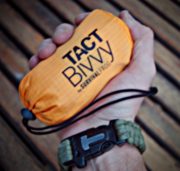
This super lightweight shelter is made of a thin material called Mylar. Mylar is a technology originally invented by NASA.
Mylar is powerful because it’s an airtight material, allowing you to trap your body heat inside the bag.
This keeps you warm enough to survive freezing temperatures. I know of no other technology that’s as lightweight and good at keeping you warm in cold weather conditions.
I even tested the Tact Bivvy in my backyard.
It was a balmy 40-degree day, and within 10 minutes, I was reading temperatures inside the bag in the 80s! (see the image for proof).
The Tact Bivvy is a “no-brainer” get home bag essential.
Here’s my video review of the Tact Bivvy.
5. High-Calorie, Non-Perishable Energy Bars
This may surprise some of you, but food is a low priority for your get home bag. Don’t get me wrong, you should stash a few calories. But you can survive several weeks with zero calories.
So even if it takes several days to “get back home,” you won’t die of starvation. But, it still makes sense to have a few calories to keep your energy up.
However, the calories you add should be a small percentage of your total get home bag’s weight.
The way you do this is to pack a couple of high-density energy bars. The higher the density of calories per ounce, the better.
Also, the food needs to be completely nonperishable. You don’t want any food you pack to spoil or go bad if left in high temperature or high moisture conditions.
That’s why we recommend stashing these in your get home bag, and you’ll be all set.
6. A Survival Knife
Most survivalists understand how versatile a quality survival knife is in the right set of hands.
A tool that can cut, slice, shave, and chop natural or man-made materials is a powerful survival device.
Now, my get home bag has a shoulder strap pouch and provides quick access in survival situations (see image).
I like having immediate access to my survival knife without rummaging through my get home bag.
I want to be able to get my hands on my knife fast, and this setup allows me to do just that.
7. 550 Paracord
The sheer number of paracord survival uses are vast. So you should always make sure you have paracord with you at all times.
I wear a survival paracord bracelet every day. But if that’s not your thing, you can always roll some up and stick it in the bottom of your get home bag.
Oh, and make sure you know how to use it. It’s not worth much if you don’t understand all the survival possibilities.
8. Small Hand Crank Radio
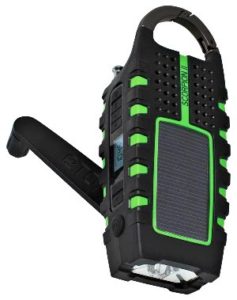
But most radios are bulky, heavy, and don’t power themselves.
Yes, most are, except this Scorpion hand-crank radio from Eton. This powerful radio is perfect for your get home bag.
You have a radio and a hand crank generator all in one. This way, you won’t need batteries to tune into emergency stations. And it’ll help keep any of your other electronic devices powered up.
That’s why this Scorpion Radio might be my most recommended piece of get home bag gear.
9 & 10. Solar Charger with Batteries
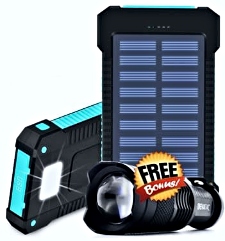
The best way to keep your radio and cell phone charged until you return home to your family is to use the sun’s power using a portable solar charger.
The Anytime Charge Power Bank is the perfect size and design for your get home bag setup.
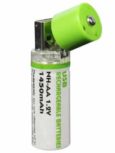
Did you catch that? Yes, you heard it right, USB rechargeable batteries – check them out.
11. Detailed Topographical Map
If you were forced to hike 50 miles outside of your city to get home, would you know the best, safest route? Do you know where all the natural water sources are?
This is where a local detailed topographical map is an essential item for your get home bag.
You need to be able to pull out the map and plan your best get home route while looking at the terrain and the emergency at hand. Use your Scorpion Hand Crank Radio to get intel on the disaster, and then use your map to figure out the safest/fastest route home.
Are there cliffs where you live and need to avoid? What about swampy areas or steep ravines?
Every city has unique terrain, and a topo map helps you navigate this terrain in a worst-case situation.
You can find Free digital topographical maps of your area online and print them off for your get home bag.
12. A Quality Compass
A map is great, but if you want to navigate successfully in unfamiliar areas, you’ll also want a compass. Humans tend to walk in a slight arch without a compass, especially in dense forests.
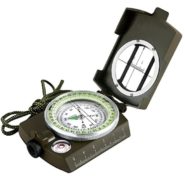
Now, most people won’t walk in circles in urban surroundings. You’ll have buildings and roads to keep your bearings, but a compass is still helpful.
I’d rather have a compass and not end up needing it than desperately needing it but didn’t pack one…
13. Tactical Pen
You should always have a writing tool in your get home bag, but it’s also handy for everyday life as well.
Sometimes you need a pen to sign a check or write a quick note.
But why not upgrade your pen to a tactical one? A pen that you can use as a self-defense weapon in a pinch.
For survival, multi-use tools are ideal, so upgrade your cheap pen to a tactical weapon.
When this post was published, you could pick up a StrikePen for FREE – just pay for shipping. Click here to see if this deal is still available.
14. Small Medical Kit
We’re focusing on lightweight and small, so you can’t build a full-fledged medical kit for your get home bag. However, you should add a small one like this with the necessary items you’ll need in a multi-day trek across your city.
Make sure it’s got painkillers, bandages, gauze, and antibiotic cream. Medical items you need to help get you home safe.
15. Tactical Flashlight
You should always have the power of illumination in your pocket or get home bag. Not all disasters happen in the middle of the day, and emergencies often include power outages.
So if you’re in an office building and all the lights go out, do you have a high-powered LED tactical flashlight? You better.
Don’t settle for a cheap plastic flashlight that requires several D-cell batteries. First, they’re prone to breakage with very little abuse and are clunky and cumbersome.
Instead, get a Firehawk Tactical Flashlight. It only takes a single AA battery; it weighs less than four oz., is super bright for its size, and can take a beating.
When this post went live, you could get a Firehawk Tactical Flashlight for FREE (pay S/H). Click here to see if this deal is still live.
16. High-Powered Taser
If you carry a firearm with you at all times, you can pass on this one. But for everyone else, you’ll want something you can use to defend yourself in an emergency.
Tasers are high-powered electrical devices that will neutralize a threat fast.
You should also have a tactical pen, but it takes more training to use a tactical pen effectively. With a high-voltage taser, it’s as simple as pulling the trigger and lunging.
17. Survival Lighter
If you must spend the night in the wilderness or a dark alleyway, you’ll want the option to start a small fire. Again, knowing all the ways to start a fire is handy in a survival situation. But I want my fire starting FAST, and RELIABLE in a get home situation.
So you can either go with a cheap lighter or upgrade to one of these best survival lighters if you want a reliable lighter you can trust.
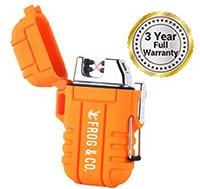
The Tesla Electric lighters are about as foolproof as you can get.
As long as you also have a means of charging it (hello, PowerBank Solar Charger).
18 & 19. EverStryke Matches & Stormproof Matches
You should always have multiple ways to start a fire. You never want to depend only on a survival lighter if you drop it in a river or get crushed underfoot; that’s why you need survival matches.
So consider adding an Everstryke Match.
Neither takes up much space or weight in your get home bag, and it’s a nice little insurance policy.
At the time of this post, you could get an EverStryke Match for FREE (take care of shipping).
20. Tinder
If you’re not experienced at starting fires, it can be surprisingly difficult. To be successful, you must start with fine ignitable tinder. Then work your way up to kindling and then full-sized logs.
Sorry, but you’ll be severely disappointed if you try to set a large log on fire with your lighter.
The good news is you can prevent this disappointment with Wetfire Tinder.
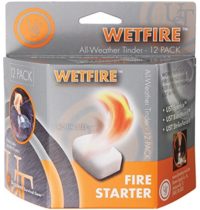
21. Rescue Whistle
I’ve always recommended having a loud survival whistle as part of any survival pack or bug out bag. Sometimes in survival, the goal is evasion, while other times, it’s rescue.
It depends on the circumstances at hand.
But the sound of a whistle carries much farther than your voice. So if you do need immediate help or attention, a survival whistle (like this one) is an excellent tool to include in your get home pack.
22. Personal Communication Antenna
Occasionally, there are cool survival gadgets that solve real survival problems.
In a widespread emergency disaster, traditional means of communication are often severed. So getting in touch with loved ones after such a disaster becomes impossible. Unless you have a couple of GoTennas.

While it’s taking you several days to make your way home in a worst-case scenario – what do you think is going on back home?
Is your family safe? Are they being forced to evacuate? If so, where are they taking them? Should they try to wait for you or follow the evacuation orders? Who’s got the kids? Who’s got the dog?
If you don’t have a backup way to communicate, you have no way to coordinate these emergency decisions.
23. Walk Friendly Footwear
This is one of the larger items to add to your get home bag. However, for some, it might also be the most important.
Are you prepared to hike home in dress shoes or high heels? Not only will such long distances cause blisters and hot spots, but you’ll also slow your progress significantly.
Maybe you can keep the boots/shoes in your vehicle instead of your get home bag. That helps to keep your get home bag smaller and lighter. But either way, find a way to include footwear you can rely on with your get home plans.
24. Hat / Gloves / Poncho / Socks
This one depends on your local climate and season. In the fall, I add a stocking cap and gloves to my get home bag and use them daily.
I also recommend adding a poncho jacket to your get home bag.
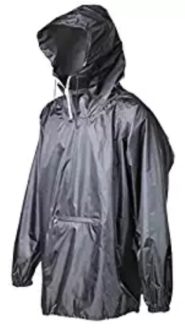
I also keep a fresh pair of smart wool socks in my get home bag. If you have wet feet for a prolonged period, you can develop trench foot.
This is a nasty condition that can limit your ability to move quickly when moving fast is the name of the game.
25. Hand / Foot Warmers
Hand/foot warmers are always a good idea in cooler climates. Frostbite at your extremities is a survival disaster in its own right.
Have you ever tried to start a fire with frostbitten fingers? It makes this already challenging survival task nearly impossible.
Stash these, and you’ll never have to worry about that.
26. Compact Binoculars
You don’t need to add large and insanely high-powered ones—the smaller, more compact, the better.
You want the upper hand in an urban evasion and escape survival situation. Being able to spot potential threats well before they spot you allows you to avoid these hazards.
This is an underappreciated survival tactic and essential to getting back home safely.
Additional Items Suggested By YOU (our readers)
Here are a few additional items SkilledSurvival readers have added to their own get home bags.
Survival Bandana
There are many possible uses for a good survival bandana. Here are 23 uses as a matter of fact. Plus, you won’t find a lighter or smaller piece of survival gear with so many uses.
And nowadays – there are even better versions called neck gaiters or face shields.
Small Stainless Steel Collapsible Cup
A cup can be a useful survival device for drinking or mixing. This one is highly collapsable and only weighs 8 oz.
Plus, at the time of writing this, there was a Buy One Get One deal in place. Click here to see if this offer is still available.
Pocket Stove
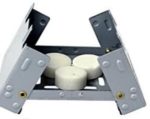
Sure, you could pack a larger portable stove, but the pocket stove is both lightweight and pocket-sized making it perfect for a get home bag.
For A Limited Time – We’re Giving Away Our Most Popular Checklists For FREE!
#104 Item Bug Out Bag Checklist or #78 Item Prepping Checklist
Get Home Bag Action Plan
You now have all the information you need to take meaningful action.
If you’ve read this far into this article, it’s time to get this done.
One aspect of all emergencies is they don’t wait until you’re ready. They happen when they happen, ready or not.
Don’t think back on this article during an all-out panic and this “damn; I should of, I could I of“…
Remember – There are no do-overs in survival.
So buy the best get home bag for you, fill it with essential survival gear, and take it with you whenever you leave the house.
Did I miss anything critical that you’d add to this list? Let me know in the comments below, and I may add it to the list.
For A Limited Time – We’re Giving Away Our Most Popular Checklists For FREE!
#104 Item Bug Out Bag Checklist or #78 Item Prepping Checklist
Remember: Prepare, Adapt, and Overcome,
“Just In Case” Jack
P.s. Are you ready for the tough times ahead?
Find out now by taking my short Readiness Score Quiz – it’s absolutely free.
Once complete, you’ll know exactly where you stand on the “fragile” vs.” resilient” spectrum.
So click here to start the Quiz….And don’t worry, the questions are so easy a 3rd grader could answer them.
Click on the image to begin the Quiz and find out once and for all if you’re part of “The Fragile Masses” or “The Resilient Few.”
The post How To Build A Get Home Bag From Scratch appeared first on Skilled Survival.


